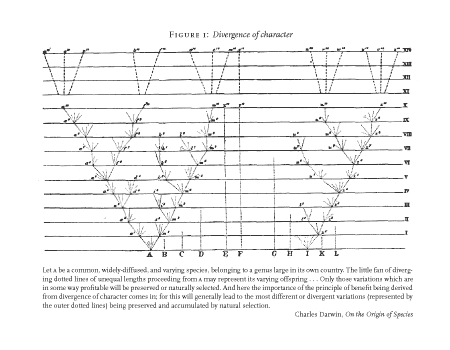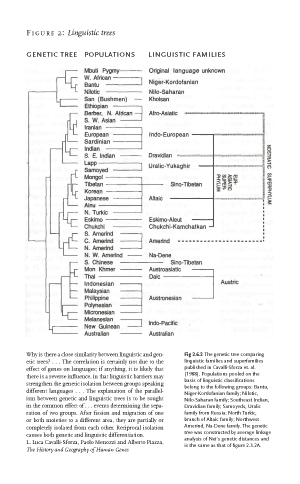Trees; evolutionary theory. They come last, in this series of essays, but were really the beginning, as my Marxist formation, influenced by DellaVolpe and his school, entailed a great respect (in principle, at least) for the methods of the natural sciences.footnote1 So, at some point I began to study evolutionary theory, and eventually realized that it opened a unique perspective on that key issue of literary study which is the interplay between history and form. Theories of form are usually blind to history, and historical work blind to form; but in evolution, morphology and history are really the two sides of the same coin. Or perhaps, one should say, they are the two dimensions of the same tree.
Figure 1 (below) reproduces the only tree—‘an odd looking affair, but indispensable’, as Darwin writes to his publisher in the spring of 1859footnote2—in The Origin of Species; it appears in the fourth chapter, ‘Natural selection’ (which in later editions becomes ‘Natural selection; or, the survival of the fittest’), in the section on ‘Divergence of character’. But when the image is first introduced, Darwin does not call it a ‘tree’:footnote3
Now let us see how this principle of great benefit being derived from divergence of character, combined with the principles of natural selection and of extinction, will tend to act. The accompanying diagram will aid us in understanding this rather perplexing subject . . .footnote4
A diagram. After the diachronic diagrams of the first article, and the spatial ones of the second, trees are a way of constructing morphological diagrams, with form and history as the two variables of the analysis: the vertical axis of figure 1 charting the regular passage of time (every interval, writes Darwin, ‘one thousand generations’), and the horizontal axis following the formal diversification (‘the little fans of diverging dotted lines’) that would eventually lead to ‘well-marked varieties’, or to entirely new species.
The horizontal axis follows formal diversification . . . But Darwin’s words are stronger: he speaks of ‘this rather perplexing subject’—elsewhere, ‘perplexing & unintelligible’footnote5—whereby forms don’t just ‘change’, but change by always diverging from each other (remember, we are in the section on ‘Divergence of Character’).footnote6 Whether as a result of historical accidents, then, or under the action of a specific ‘principle’,footnote7 the reality of divergence pervades the history of life, defining its morphospace—its space-of-forms: an important concept, in the pages that follow—as an intrinsically expanding one.
From a single common origin, to an immense variety of solutions: it is this incessant growing-apart of life forms that the branches of a morphological tree capture with such intuitive force. ‘A tree can be viewed as a simplified description of a matrix of distances’, write Cavalli-Sforza, Menozzi and Piazza in the methodological prelude to their History and Geography of Human Genes; and figure 2, with its mirror-like alignment of genetic groups and linguistic families drifting away from each other (in a ‘correspondence [that] is remarkably high but not perfect’, as they note with aristocratic aplomb),footnote8 makes clear what they mean: a tree is a way of sketching how far a certain language has moved from another one, or from their common point of origin.
And if language evolves by diverging, why not literature too?

